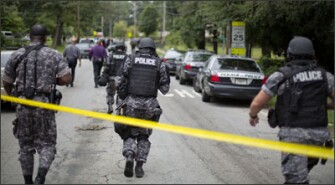
Ohio’s top legal expert has some dismaying news: His state’s school district safety plans need a lot of work.
Attorney General Mike DeWine said at a conference Monday that while all schools meet the minimum obligation to have a safety plan, many of those plans don’t amount to much, according to the Columbus Dispatch. DeWine said 180 school buildings haven’t updated their plans in at least three years, and 56 others are incomplete. Others are so long as to be cumbersome and effectively useless. He also said the state can’t really do anything about it.
Ohio’s difficulties underlie that what should be one of the most important policies a school can have is often hard to craft and implement.
The School Safety and Emergency Management Planning Conference at which DeWine spoke comes under the ever-present pall of December’s school shootings at Sandy Hook Elementary School, in Newtown, Conn. That district continues efforts to recover from the tragedy that left 26 students and staff dead. Just today, construction crews began installing a new fence around the school (which is set to be demolished), replacing concrete barriers and traffic cones.
The shootings in Sandy Hook prompted a wave of school safety legislation that has ultimately fallen short of any federal reform and struggled for momentum at the state level. Most of what has passed involves improving overall school climate and creating emergency plans, but as Ohio demonstrates, that’s not always easy.
Take, for another example, the Clarksville, Ark., school district, which continues to grapple with a plan to arm teachers like private guards. Since the Associated Press reported the plan at the end of July, state Attorney General Dustin McDaniel labeled the program illegal and called for the public disclosure of the names of all staff involved in the training. Last week, things got worse for the district when a state licensing panel suspended the training licenses of all involved, in response to McDaniel’s opinions. This means that, barring a legislative change, the district will have sunk $70,000 into a school safety plan without any tangible benefit.
There is, I think, a basic parental expectation that their children will be safe in schools. Not free from all possible harm, necessarily, nor even immune from the worst dangers. Certainly there are bullies, or accidents, or random acts of nature, but the hope is that schools have a workable plan to respond to those things; that if they can’t be perfectly proactive about everything, they can be properly reactive to most things.
Federal agencies have offered thorough advice about safety to schools, but the inherent question of balancing what’s safe against what’s reasonable depends on district leadership. As teacher Nancy Hahn writes in an Education Week Commentary published today, school safety strategy requires teamwork among all levels of the district—students, parents, teachers, administrators, and community members—and building consensus requires a lot of persistence. That’s before considering the broader regulations that ham-strung Clarksville.
So why, nine months after the Newtown shootings, do school districts continue to have trouble with school safety planning?
Many of the troubles seem to boil down to bureaucratic missteps.
There’s also funding to consider; school resource officers, bulletproof glass, and security cameras aren’t free or even cheap, especially for schools that can’t afford classroom necessities like chalk. (Chalk costs $3. Police dogs cost $20,000 just for the training.)
Or perhaps, as Hahn writes, problems arise because no two people think alike on school safety. Some want officers in schools, while opponents abhor that idea. Some want guns, and others are adamantly opposed. Administrators can make top-down decisions, but teachers have to be on board for those strategies to be effective.
In Decatur, Ga., today, police arrested an alleged gunman who fired shots at Ronald E. McNair Discovery Learning Academy, an elementary school. All students and teachers were reportedly safe. Decatur and federal officials continue to sort out the details.
But the Decatur incident shows that violence is all too common and unpredictable. What will it take for schools to be adequately prepared?
Image: DeKalb County Police SWAT officers run toward Ronald E. McNair Discovery Learning Academy after a gunman armed with an assault rifle entered the school in Decatur, Ga. DeKalb County Schools Superintendent Michael Thurmond praised faculty and authorities who evacuated all students to safety, saying it is a ‘blessed day, all our children are safe.’ —David Goldman/AP